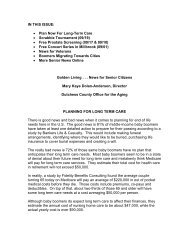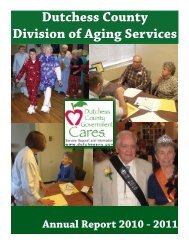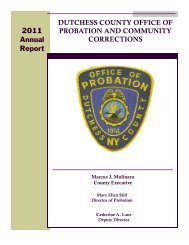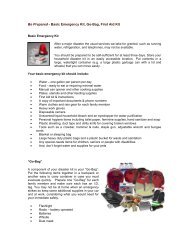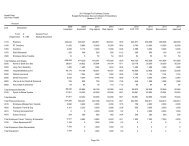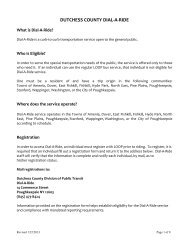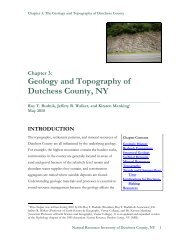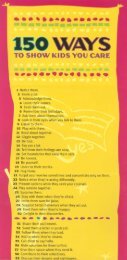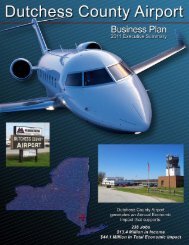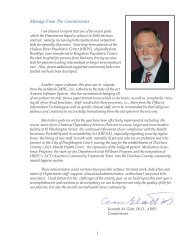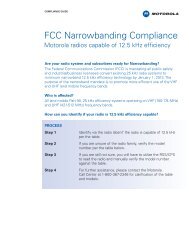Making the Connection Building the Future - Dutchess County
Making the Connection Building the Future - Dutchess County
Making the Connection Building the Future - Dutchess County
You also want an ePaper? Increase the reach of your titles
YUMPU automatically turns print PDFs into web optimized ePapers that Google loves.
2007<br />
Temporary Assistance & Employment Units<br />
This division handles four major programs. They<br />
are: Family Assistance, Safety Net Assistance,<br />
Employment and Training, and Day Care.<br />
FAMILY ASSISTANCE<br />
This is provided to a family that includes a minor<br />
child living with a caretaker relative, or to a pregnant<br />
woman. Adults and minor heads of households receiving<br />
assistance are subject to a life-time limit of 60<br />
months after which <strong>the</strong> individual becomes ineligible<br />
for cash assistance unless he or she meets very strict<br />
exemption criteria.<br />
The Family Assistance program fosters recipient selfsufficiency.<br />
Recipients undergo an assessment of <strong>the</strong>ir<br />
employability skills, training needs, and unless exempted,<br />
must participate in assigned work activities.<br />
Employed recipients are now able to have 47 percent<br />
of <strong>the</strong>ir gross earnings disregarded when determining<br />
<strong>the</strong>ir need for assistance and level of benefit.<br />
SAFETY NET ASSISTANCE<br />
Safety Net Assistance (SNA) is a temporary assistance<br />
program that is funded jointly by New York State and<br />
counties. Individuals and families, who are ineligible<br />
for Family Assistance or o<strong>the</strong>r federally reimbursed<br />
Temporary Assistance programs, receive Safety Net<br />
Assistance (SNA). Most SNA recipients are single<br />
individuals or childless couples. They must engage in<br />
assigned work activities to receive assistance, unless<br />
exempted by a physical or mental disability.<br />
Safety Net Assistance consists of two components:<br />
cash and non-cash. In <strong>the</strong> non-cash component, food,<br />
shelter, fuel and utility allowances are issued directly<br />
to <strong>the</strong> vendor leaving <strong>the</strong> recipient with only a small,<br />
if any, personal needs allowance. SNA is provided<br />
as cash unless <strong>the</strong> household falls into one of <strong>the</strong><br />
four categories, which must receive non-cash. These<br />
categories are:<br />
Households with an adult who has reached <strong>the</strong> 24-<br />
month lifetime limit on cash assistance.<br />
Households with an adult head of household who is<br />
unable to work because of substance abuse.<br />
Households with an adult or head of household who<br />
has refused to participate in drug/alcohol screening,<br />
assessment, or treatment.<br />
Families that have reached <strong>the</strong> five-year (60 months)<br />
limit on Family Assistance.<br />
Cash SNA recipients are limited to a 24 month lifetime<br />
limit of cash assistance, with months counted<br />
since <strong>the</strong> August 1997 start of <strong>the</strong> SNA program. After<br />
<strong>the</strong> 24th month, assistance must be provided as noncash<br />
SNA, unless <strong>the</strong> adult head of <strong>the</strong> household is<br />
exempt due to disability or an HIV positive status.<br />
TEMPORARY ASSISTANCE<br />
This unit:<br />
Determines eligibility for <strong>the</strong> various programs. Screens<br />
all applicants for domestic violence, drug and/or alcohol<br />
abuse, and any o<strong>the</strong>r physical or psychological barriers<br />
to employment and refers individuals to <strong>the</strong> Domestic<br />
Violence Liaison, Certified Alcohol and Substance Abuse<br />
Family Assistance Cases as of 1/1/07<br />
1985........................................................................ 1,544<br />
1990........................................................................ 1,519<br />
1995........................................................................2,387<br />
2000........................................................................ 1,001<br />
2005........................................................................... 683<br />
2007........................................................................... 581<br />
Safety Net (As of 1/1/07)<br />
1985........................................................................... 578<br />
1990........................................................................... 649<br />
1995........................................................................... 968<br />
2000........................................................................... 361<br />
2005............................................................................519<br />
2007........................................................................... 553<br />
Temporary Assistance<br />
Case Activity* 1/1/07<br />
2006 2007<br />
Applications Registered................... 7,098............7,317<br />
Cases Opened/Reactivated/<br />
Open-Closed.....................................2,823........... 3,127<br />
Withdrawn............................................. 252...............213<br />
Denied................................................4,404........... 4,208<br />
Cases Closed.....................................2,050........... 2,108<br />
Recertifications.................................. 1,454........... 1,220<br />
Changes to Active/<br />
Closed Cases..................................... 8,081...........9,943<br />
Totals – Case Activity.....................19,064.........20,891<br />
*From WMS WST002<br />
The Temporary Assistance<br />
and Employment<br />
Units consist of Employables,<br />
Individuals<br />
with Barriers, Child only<br />
cases, and Child Care.<br />
Toge<strong>the</strong>r <strong>the</strong>y work to<br />
promote self-sufficiency,<br />
personal responsibility<br />
and “work first.” We<br />
expect adult applicants<br />
and recipients to make<br />
“employment” <strong>the</strong>ir first<br />
priority and will make<br />
<strong>the</strong>ir primary goal, finding<br />
a job regardless of<br />
any barriers that must be<br />
overcome.<br />
36 2007 DSS ANNUAL REPORT :: www.dutchessny.gov



